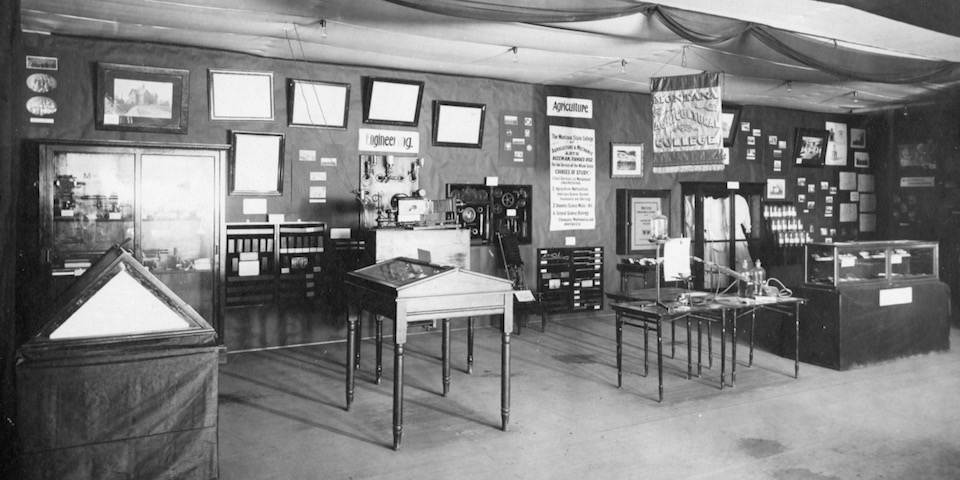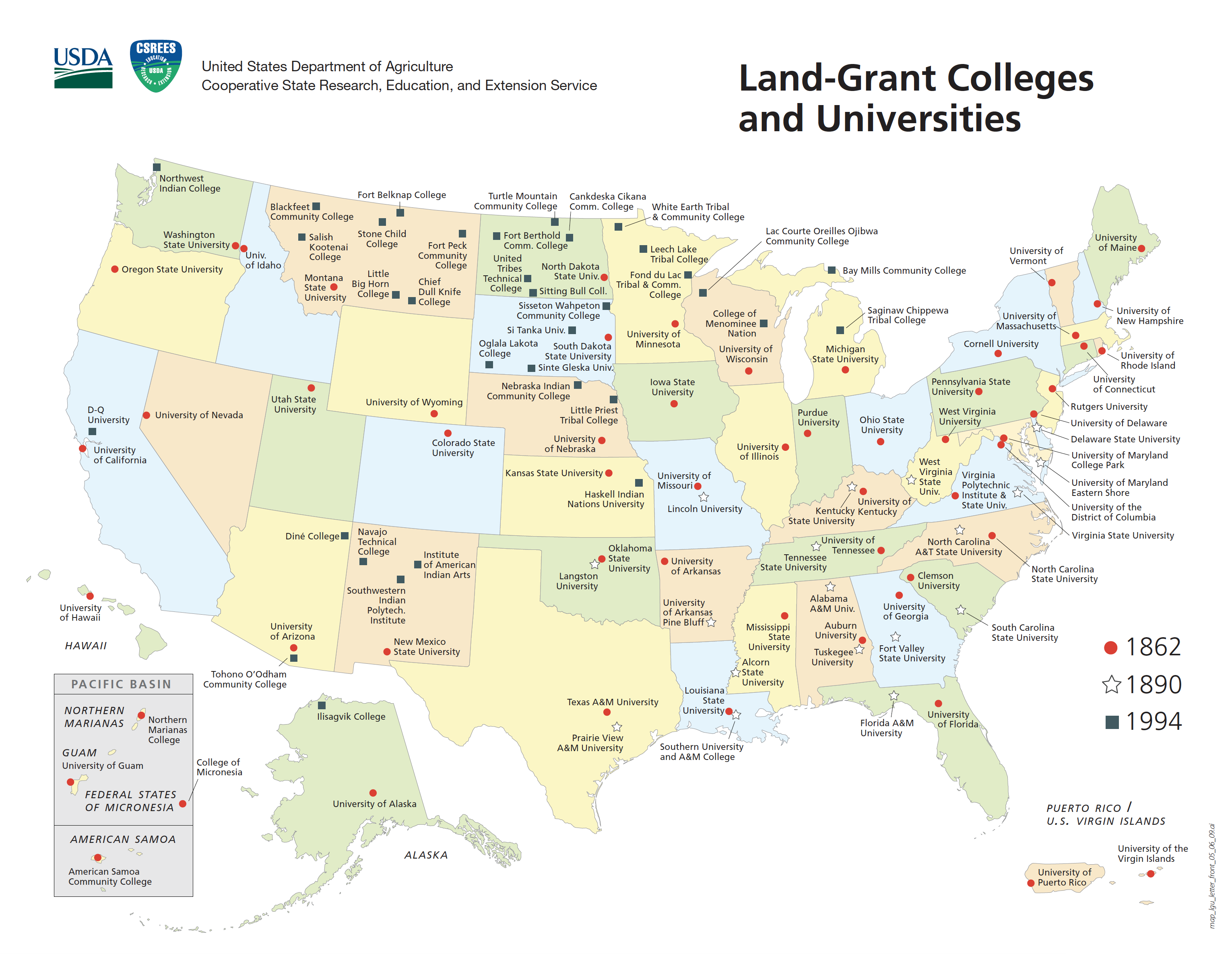College of Agriculture History
The College of Agriculture has extisted for as long as Montana State University has, founded as Montana State College in 1893. We are proud to be the state's flagship agricultural college and a regional leader in education, research and engagement.
MSU is one of more than 110 land-grant universities (LGUs) in the U.S.
An LGU is an institution that has been designated by its state legislature or by Congress to receive the benefits of the Morrill Acts of 1862 and 1890. The mission of these institutions was to teach agriculture, military tactic and the mechanical arts, so that members of the working classes could obtain a practical education.
Passage of these acts reflected a growing demand for agricultural and technical education in the United States. They provided a broad segment of the population with an education that had direct relevance to their daily lives.
To aid in bringing the most relevant agricultural research to the public and into the classroom, Congress passed the Hatch Act of 1887, which provided federal funds to each state for the establishment of an agricultural experiment station to be run in conjunction with the Land-Grant institution.
To disseminate information generated from the experiment stations’ research, the Smith-Lever Act of 1914 created a Cooperative Extension Service associated with each Land-Grant institution.
Montana’s Land Grant University
Following statehood in 1889, Montana became eligible for the provisions of the Morrill and Hatch Acts and formed the Agricultural College of the State of Montana and the Montana Agricultural Experiment Station in 1893. The Montana Cooperative Extension Service was formed in 1914 following the passage of the Smith-Lever Act.
1866: F.B. Linfield born on the island of Twillingate north of Newfoundland, Canada on July 17.
1893: Students in the Agriculture Department: 8
First buildings on campus were an assortment of structures from the City of Bozeman’s poor farm, a few log cabins and small outbuildings. In the first year, the College offered:
- Preparatory course of one year for underprepared students;
- A one year course in bookkeeping, typing, shorthand, commercial law and office practice;
- Piano courses;
- Courses in agriculture, applied science, and a ladies’ course. Ag courses included horticulture, livestock, entomology, veterinary medicine, botany and chemistry.
The first agricultural faculty were:
- A.M. Ryon, President of the College and a mining engineer
- S.M. Emery, Horticulture, Director of the Experiment Station
- L. Foster, Agronomy and Botany
- W.L. Williams, professor of Veterinary Science
- F.W. Traphagen, Chemistry and Natural Science
- B.F. Maiden, English
The Farmers’ Institute offered short courses to producers on a variety of topics such as hog and cattle production. Sixteen Farmers’ Institutes were held in the winter of 1893-94.
1898: MSU Herbarium founded by H.S. Jennings in the Botany Department, which also did early work on Montana grasses and poisonous plants.
1899: Montana Entomology Collection founded by R.A. Cooley, the first Experiment Station entomologist. Among the other notable early work were grasshopper control and investigations on the cause of Rocky Mountain spotted fever.
1900: New orchard of 125 varieties was cultivated. The Montana ‘McIntosh’ apple becomes a national favorite due to good insect control. Its advertising slogan was “This apple can be eaten in the dark.”
1904: Linfield named director of the Montana Agricultural Experiment Station following the resignation of S. Fortier.
1905: Dairy Department, Animal Industry Department, and Agronomy Department were established. Botany and Zoology were combined into a new Biology Department.
1906: Students in the School of Agriculture: 23
President James Hamilton expanded the single course in agriculture to include majors in agronomy, animal industry, dairy and horticulture. To enter, a student must have finished the eighth grade and be able to read and write, or take a group of preparatory classes to enter.
1907: Students in the School of Agriculture: 50
President Hamilton called for a new building for agriculture. At the time there were only three significant brick structures on campus. Agricultural Hall (Linfield Hall) was the first constructed with 20th century techniques, such as the use of concrete, and cost $80,000 to construct.
1908: The first “special train” furnished by Northern Pacific railroad was organized by Experiment Station personnel in 1908 in a major effort to extend information to Montanans. (Prior to 1910 all four railroads in the state offered free travel for Experiment Station personnel. This was later ruled illegal by the Montana Supreme Court.)
1909: Students in the Agriculture Department: 40.
Montana State College had 10 teaching faculty in agriculture and 17 Experiment Station staff.
1909 -1923: Settlers filed 114,620 homestead claims on 25 million acres in Montana.
1911: The first greenhouse was built on campus. It was the largest of several greenhouses authorized by the state and made of iron, glass and cypress with a cement foundation.
1913: Linfield appointed as the first Dean of the College of Agriculture and the Director of the Experiment Station.
273 farmers and homemakers registered for a one week short course, which developed into “Farm and Home Week”.
Agricultural Experiment Station celebrates 20th anniversary. Linfield called the first 10 years the “Pioneer Years” and the second 10 the “Construction Years”.
1914: Extension takes over administration of Farm and Home Week, which continued until 1930.
1915: Farm Management Department formed; Biology Department renamed Biology and Bacteriology Department.
1916: Students in the School of Agriculture: 125.
161 Farmers’ Institutes held with 21,334 attendees.
Farmers’ Institute merges with Montana Extension Service.
Several Experiment Station workers laid up with the flu; some offices and labs in the agriculture building were abandoned, with some areas used for a student hospital.
1921: Students in School of Agriculture: 173.
1924: Mrs. Mary “Polly” Linfield died of pneumonia in Bozeman on New Year’s Eve.
1925: Agricultural Economics and Home Economics departments formed.
1926: Herrick Hall completed for Home Economics Department at a cost of $151,000.
1927: The topic for the special train for that year was “Better Livestock, Better Feed”.
1928/29: Greatest registration for Farm and Home Week, totaling 453 participants.
1929: “Unit” courses offered for the last time and replaced by “group courses” in “diversified farming”, “livestock production”, and “tractor grain farming”. These were discontinued in 1933 due to the Depression.
1937-38: Students in the School of Agriculture: 274.
1937: Linfield announced his retirement as Dean and Director.
1942: Entomology Department becomes Zoology and Entomology Department and transfers to the College of Letters and Science.
1946: First 2,4-D applied in Montana at agricultural research centers in Moccasin and Havre. Beginning of the use of growth regulators for weed control.
Plans for the Montana elevated milking stall first published, now a standard in American dairies.
1948: Linfield died in his daughter’s home in Billings on September 24.
1962: Agronomy and Soils Department renamed the Plant and Soil Science (P&SS) Department. Horticulture Department merged with P&SS Department.
1968: Morrill Hall officially named Linfield Hall.
1998: Plant Sciences merges with Plant Pathology and becomes the Plant Sciences and Plant Pathology Department (PSPP). Soil Science reorganizes into the Land Resources and Environmental Sciences Department (LRES).
2007: Students in the College of Agriculture: 800.
Number of faculty in the College of Agriculture, Montana Agricultural Experiment Station and Extension Service: 138.
Today, the departments and divisions in the College of Agriculture are Agricultural Economics and Economics; Agricultural and Technology Education; Animal and Range Sciences, Land Resources and Environmental Sciences, Microbiology and Cell Biology; Plant Sciences and Plant Pathology; the WIMU Regional Program in Veterinary Medicine; and the Department of Research Centers. The College of Agriculture serves nearly 2,000 students.
Construction of the building began in 1907 and was completed on September 16, 1908. Fifty students were hired to move furniture into the new building over Christmas break, and the building was dedicated on February 6, 1909.
Originally known as the Agriculture Building or Agricultural Hall, then as Morrill Hall until the 1960s, it was built for $80,000. The 17-inch thick exterior walls supported a red tile roof, reportedly only the second building in the state to have such a roof. The 13-inch thick interior walls were trimmed in red and white oak and Carolina pine and all floors were made of maple with the exception of the ground floor, which was poured terrazzo. Most of the original woodwork and all of the original floors remain to this day.
The south wing was constructed between 1952-54. Once completed, the Animal and Dairy Industry Department and the Range Management Department moved into the new space. The Department of Animal and Range Sciences could be found in the south wing until 2010 when it moved into the new Animal Bioscience Building across 11th Avenue.
The building was renamed Linfield Hall in 1968 after Frederic Bloomfield Linfield, professor of agriculture, MAES Director from 1904 to 1937, and Dean of the College from 1913 to 1937.
Professor Linfield came to Montana in1902 after serving ten years with the Utah Agricultural Experiment Station. He began a dryland research program in 1906 after a buggy trip around the state to learn the concerns of Montana’s producers. Linfield was appointed as the first Dean of the School of Agriculture in 1913 and remained Dean until his retirement. Professor Linfield managed the early development of policies, procedures and direction for both MAES and the College of Agriculture, laying the foundation for the institutions as they exist today—responsive to the needs of producers and students.
Over time, leadership at the College of Agriculture and MAES has taken different forms. Since 1903, the director of MAES and dean of the college have been a combined appointment. Beginning in 2014, the dean/director has also served as Vice President for Agriculture, a member of the MSU president's executive team.
Currently, COA/MAES leadership consists of a Vice President/Dean/Director, one or two associate deans, one assistant dean and one MAES associate director.
- Sreekala Bajwa: 2019-present
- Charles Boyer: 2014-2019
- Glenn Duff (Interim): 2013-2014
- Jeff Jacobsen: 2003-2013
- Sharron Quisenberry: 1999-2003
- Stuart Knapp (Interim): 1998-1999
- Tom McCoy: 1994-1998
- Barry Jacobsen: 1992-1994
- Max Amberson (Interim): 1991-1992
- James Welsh: 1980-1990
- Johan Asleson: 1965-1980
- Roy Huffman: 1958-1965
- Maurice M. Kelso: 1954-1958
- Clyde McKee: 1937-1954
- Frederic B. Linfield: 1903-1937
- Jennifer Thomson (Academic Programs) and Darrin Boss (Research): 2023-present
- Tracy Dougher: 2018-2023
- Nora Smith: 2011-2017
- Robert Gough: 2005-2010
- Don Kress: 1999-2005
- Clayton Marlow: 1989-1998
- Daniel Bartell: 1982-1989
- Lark Carter: 1964-1982
- Harry G. Cockrum: 1948-1962
- Darrin Boss: 2023-present
- Mary Burrows: 2020-2023
- Anton Bekkerman: 2018-2020
- Barry Jacobsen: 2015-2017
- Russell Muntifering: 1988-1990
- Martin Burris: 1964-1981
- Johan Asleson: 1958-1961
- Samuel Fortier ~ 1900-1903
- Sloan M. Emery ~ 1893-1900
- Robert Gough ~ 2005-2010
- Don Kress ~ 1999-2005
- Clayton Marlow ~ 1992-1998
- Harry G. Cockrum ~ 1958-1962
- Johan Asleson ~ 1956-1962
- Harry G. Cockrum ~ 1948-1954


